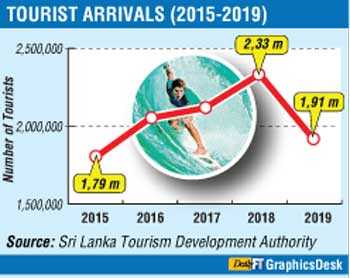Monday Apr 07, 2025
Monday Apr 07, 2025
Saturday, 4 January 2020 00:02 - - {{hitsCtrl.values.hits}}
 By Charumini de Silva
By Charumini de Silva
Contrary to preliminary projections, tourist arrivals have reached the 1.9 million revised target for 2019, despite it being a 'crisis year' following the Easter Sunday tragedy.
“Sri Lanka ended 2019 with 1.91 million tourists. Tourist arrivals during December reached a record 241,663, highest received post Easter Sunday tragedy,” an official told the Weekend FT.
The 2019 performance, however, was still 18% lower in comparison to the record achievement of 2.3 million in 2018. December 2019 arrivals were lower by 4.5% from a year earlier as well.
Sri Lanka originally targeted 2.5 million tourist arrivals for 2019, but the Sri Lanka Tourism Development Authority (SLTDA) revised it in August post-Easter Sunday terror attacks, stating that it hoped to get around 2–2.1 million tourists, reflecting a 10% decline over 2018. The SLTDA subsequently revised the annual projection again to 1.9 million.
In April, soon after Easter Sunday, tourism officials estimated a $ 1.5 billion revenue loss this year, while projecting a 30% drop in arrivals.
The record haul in December overshadowed industry concerns following the Easter Sunday tragedy, political instability, delay in launching an aggressive public relations and marketing campaign in the aftermath of the Easter Sunday attacks, and the Presidential Election, which were highlighted as potential causes of the country missing the 1.9 million arrivals target.
Sri Lanka was able to record a positive growth in tourist arrivals only during the first three months of 2019, with February being the highest 252,033 up by 7% compared to the same period in 2018.
Following the Easter Sunday terror attacks, tourist arrivals to Sri Lanka slumped sharply, but improved gradually during the winter season from October.
The country recorded its highest growth, 46.1%, in 2010, following the end of the near 30-year-old conflict. Thereafter, the growth trajectory saw a downward trend in 2011 and in 2012, posting a 30.8% and 17.5% growth respectively. However, in 2013, there was a positive growth of 26.7%, which subsequently went on a descending trend for five years.
Under the leadership of President Gotabaya Rajapaksa’s policy framework, tourism has been recognised as a thrust sector for economic development in Sri Lanka.